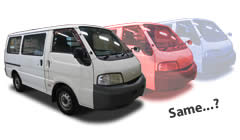Why The Mazda Bongo, The Mitsubishi Delica And The Nissan Vanette Look The Same - Vol.180
During the mid-1960's, Mazda designed and began manufacturing its long-lasting and popular Bongo series of vans; for nearly a decade, the van was produced with very little changes from one model year to the next. It was a strong, sturdy cargo van capable of hauling half a ton with little effort. However, due to some financial troubles, Mazda suspended the production of the Bongo in 1975. Two years later, it resumed production of a new generation of Bongo van that was now built with bigger, stronger engines. The model has been popular enough and a good seller for Mazda, so the production has continued with some minor overhauls throughout its forty-year lifespan. Today, the Bongo is on its fourth generation; sadly, this will be the last of its kind as Mazda announced in 2012 that it would switch its attention of in-house designed vehicles toward more fuel-efficient car models.

Mitsubishi motors, two years after Mazda first began producing the Bongo, rolled out the Delica, a model of truck, passenger van and cargo van built on the same chassis. The passenger van was eventually discontinued, but the cargo van has continued as a popular model for Mitsubishi. It has undergone a few retooling efforts throughout the years, and now is on the fifth generation of the model.
In the late 1970s, Nissan released the Nissan Vanette as a replacement for a previous van model known as the Nissan Cherry Cab. It was similar in shape and form to both the Bongo and the Delica, yet it featured several interior designs that were different from either of the other cargo van types with which it was competing. The Vanette has undergone several redesigns in order to help keep up with the minivan market in the United States. The Vanette, which has continued to be a steady seller, is on its fourth generation.
These van models have been popular sellers around the world, however it is impossible not to notice that the designs of all three of the vehicles is strikingly similar. This is because, in recent years, both the Delica and the Vanette have been "badge engineered." Both of these models began their lives as Mazda Bongos. Rather than have a completely new design created and implemented, the manufacturers opted to simply take the Mazda body and put a different manufacturer's name, logo and model type on the car.
In simpler terms, the Mazda Bongo, Mitsubishi Delica, and Nissan Vanette look the same because they are the same!
Badge engineering, sometimes called "rebadging," is a fairly common practice where the same automobiles and place different names and company logos on the vehicles. Sometimes, there are minor differences between the model types, such as in the headlights, the taillights. The different brands might also feature different engines and the interiors are typically slightly changed, as well. This is especially common when one parent company owns several different car manufacturers; General Motors is a prime example of this.
The main reason for this is the cost of design and implementation. It can take years to create a new design from the ground up, and even then there are no guarantees that the new design will be accepted. It is easier simply to take an existing brand, remove the old name and install a new one; thus the term "rebadging" is born.
Badge engineering of the Mazda Bongo has not been limited to Mitsubishi and Nissan, however. In the 80s, South Korean automobile manufacturer Kia rebranded the Mazda Bongo as their own version, called the Kia Bongo. Ford, which has a small investment in Mazda, has been rebadging the Bongo as the Econovan since the second generation Bongo was released in 1977. Mazda has even cannibalized itself, rebadging the Bongo as the Mazda E-Series in foreign markets. This is also a common reason for bade engineering: when the automobiles are released overseas, the manufacturers will give a new name to the model that is more appealing to the potential buyers in the new market.